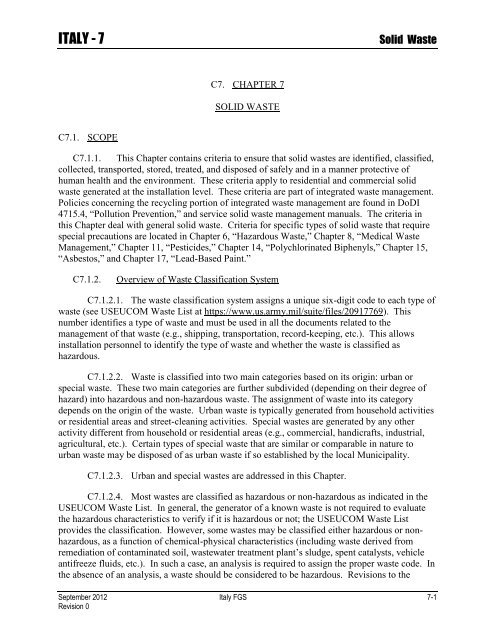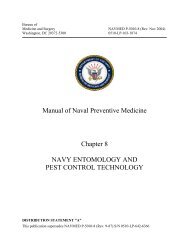ENVIRONMENTAL FINAL GOVERNING STANDARDS ITALY
ENVIRONMENTAL FINAL GOVERNING STANDARDS ITALY
ENVIRONMENTAL FINAL GOVERNING STANDARDS ITALY
Create successful ePaper yourself
Turn your PDF publications into a flip-book with our unique Google optimized e-Paper software.
<strong>ITALY</strong> - 7 Solid Waste<br />
C7.1. SCOPE<br />
C7. CHAPTER 7<br />
SOLID WASTE<br />
C7.1.1. This Chapter contains criteria to ensure that solid wastes are identified, classified,<br />
collected, transported, stored, treated, and disposed of safely and in a manner protective of<br />
human health and the environment. These criteria apply to residential and commercial solid<br />
waste generated at the installation level. These criteria are part of integrated waste management.<br />
Policies concerning the recycling portion of integrated waste management are found in DoDI<br />
4715.4, “Pollution Prevention,” and service solid waste management manuals. The criteria in<br />
this Chapter deal with general solid waste. Criteria for specific types of solid waste that require<br />
special precautions are located in Chapter 6, “Hazardous Waste,” Chapter 8, “Medical Waste<br />
Management,” Chapter 11, “Pesticides,” Chapter 14, “Polychlorinated Biphenyls,” Chapter 15,<br />
“Asbestos,” and Chapter 17, “Lead-Based Paint.”<br />
C7.1.2. Overview of Waste Classification System<br />
C7.1.2.1. The waste classification system assigns a unique six-digit code to each type of<br />
waste (see USEUCOM Waste List at https://www.us.army.mil/suite/files/20917769). This<br />
number identifies a type of waste and must be used in all the documents related to the<br />
management of that waste (e.g., shipping, transportation, record-keeping, etc.). This allows<br />
installation personnel to identify the type of waste and whether the waste is classified as<br />
hazardous.<br />
C7.1.2.2. Waste is classified into two main categories based on its origin: urban or<br />
special waste. These two main categories are further subdivided (depending on their degree of<br />
hazard) into hazardous and non-hazardous waste. The assignment of waste into its category<br />
depends on the origin of the waste. Urban waste is typically generated from household activities<br />
or residential areas and street-cleaning activities. Special wastes are generated by any other<br />
activity different from household or residential areas (e.g., commercial, handicrafts, industrial,<br />
agricultural, etc.). Certain types of special waste that are similar or comparable in nature to<br />
urban waste may be disposed of as urban waste if so established by the local Municipality.<br />
C7.1.2.3. Urban and special wastes are addressed in this Chapter.<br />
C7.1.2.4. Most wastes are classified as hazardous or non-hazardous as indicated in the<br />
USEUCOM Waste List. In general, the generator of a known waste is not required to evaluate<br />
the hazardous characteristics to verify if it is hazardous or not; the USEUCOM Waste List<br />
provides the classification. However, some wastes may be classified either hazardous or nonhazardous,<br />
as a function of chemical-physical characteristics (including waste derived from<br />
remediation of contaminated soil, wastewater treatment plant’s sludge, spent catalysts, vehicle<br />
antifreeze fluids, etc.). In such a case, an analysis is required to assign the proper waste code. In<br />
the absence of an analysis, a waste should be considered to be hazardous. Revisions to the<br />
September 2012 Italy FGS 7-1<br />
Revision 0
















